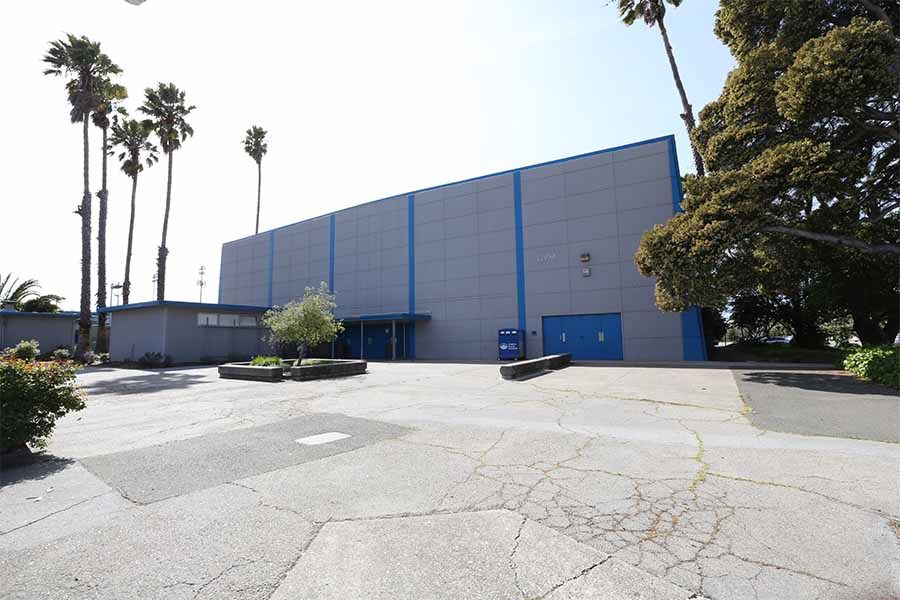$29 million allocated for remodel
Project enters design phase, construction set to start in early 2019
Mar 29, 2017
Following the successful opening of the re-designed Campus Center, the second phase of construction now shifts to the athletic department and its dilapidated post-WWII era structures that are in desperate need of attention.
Last August, the College Council at Contra Costa College, unanimously approved a $29 million budget to revitalize the Gym Annex, Gymnasium and both locker rooms using Measure E funds.
Measure E is a $450 million bond measure that was passed by Contra Costa County voters in 2014.
Contra Costa College Community College District Facilities Planner Ray Pyle said CCC was allocated $95 million in total.
District Project Manager P.J. Roach said the CCC PE/Kinesiology Complex renovation has completed the programming phase and is about to move into the schematic design phase.
He also said the scope of the project will consist of a complete renovation of the Gym Annex, Gymnasium, and the Men’s and Women’s locker rooms.
“There will also be a small addition to the Gymnasium that will include a lobby, new restrooms, a concession stand and a new classroom,” Roach said. “All buildings will receive updated mechanical and electrical systems, new roofs and new finishes (paint, flooring, ceilings).”
According to Roach, the complete design process, including obtaining state approval of the design, is expected to last into late 2018. Construction will start in early 2019 and, at this time, is estimated to take 16 months to complete.
“With the renovations happening I’m sure we will be satisfied with what is going on and I’m sure they will address everything that needs to be done,” Comet men’s basketball coach Miguel Johnson said. “I’m looking forward to it. My main concern is where classes will be held for sports teams during construction.”
Johnson said some community locations may be relocation options, like the soccer field at nearby Helms Junior High School or at sister college Diablo Valley, in Pleasant Hill.
“It’s going to be the most difficult part of the whole process, but it will be well worth it,” he said.
Although many expected the facilities to be completely rebuilt, like the upper-portion of the campus, a complete reconstruction in the same area is seismically impossible.
Months of soil testing to gauge the stability of the earth beneath the athletic facilities yielded inconclusive results.
Soil inspection places a building site into one of three zones.
Green zones mean the area is clear of fault activity, while red areas show fault traces and are unsafe to build on.
Most of the lower portion of the CCC campus, which contains the GA Building, falls into the uncertain yellow zone.
In those areas, trench workers have not found fault activity in the soil, but they have yet to dig deep enough to discover pre-holocene soil (soil that is 11,700 years old).
It was imperative that soil inspection find pre-holocene soil, which would have signaled an acceptable amount of seismic activity, allowing new construction.
The Hayward Fault bisects the campus and runs very close to the soon-to-be construction zone.
Many in the athletic department are just happy the 16-month renovation plans are moving in a positive direction after accepting the reality that facilities will not be re-built, just refurbished.
CCC swim instructor Jim Ulversoy says athletic department staff have been present during discussions and have been able to make suggestions as to what changes will have the most positive effect for students.
“I’ve been able to voice my opinion in meetings and I have had input. I don’t know how much it counts,” Ulversoy said. “Hopefully we will have room for lifeguards, a bigger staff room, an improved pool office and an equipment storage room.”
Ulversoy said another issue is deciding if Measure A funding will be used to resurface the pool deck and tennis courts. However, he said that decision will have to be made at the district level.
The feeling that it has been too long since buildings in the athletic department have received the attention they deserve is unanimous.
Information on energy.gov, the Office of Energy Efficiency and Renewable Energy, says renovation, retrofit and refurbishment of existing buildings represents an opportunity to upgrade the energy performance of commercial building assets.
With the district renovation plan entering the design phase, and most of the structural problems getting addressed, the only thing left up for debate is which area of the department will receive attention first.
“Anywhere is a good place to start, and for what we’re getting things seem to be moving in the right direction,” Athletic Director John Wade said. “I don’t have any preference where the work begins — just that we start.”



